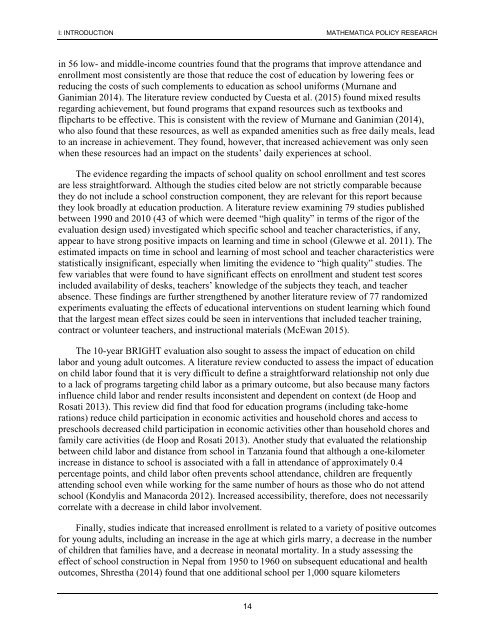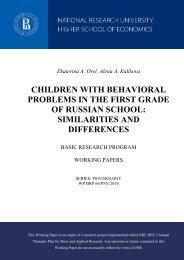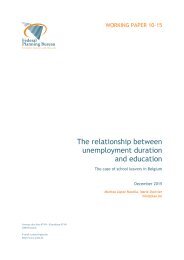Ten-Year Impacts of Burkina Faso’s BRIGHT Program
n?u=RePEc:mpr:mprres:2ecdd42bb503422b802ce20da2bf64b7&r=edu
n?u=RePEc:mpr:mprres:2ecdd42bb503422b802ce20da2bf64b7&r=edu
You also want an ePaper? Increase the reach of your titles
YUMPU automatically turns print PDFs into web optimized ePapers that Google loves.
I: INTRODUCTION MATHEMATICA POLICY RESEARCH<br />
in 56 low- and middle-income countries found that the programs that improve attendance and<br />
enrollment most consistently are those that reduce the cost <strong>of</strong> education by lowering fees or<br />
reducing the costs <strong>of</strong> such complements to education as school uniforms (Murnane and<br />
Ganimian 2014). The literature review conducted by Cuesta et al. (2015) found mixed results<br />
regarding achievement, but found programs that expand resources such as textbooks and<br />
flipcharts to be effective. This is consistent with the review <strong>of</strong> Murnane and Ganimian (2014),<br />
who also found that these resources, as well as expanded amenities such as free daily meals, lead<br />
to an increase in achievement. They found, however, that increased achievement was only seen<br />
when these resources had an impact on the students’ daily experiences at school.<br />
The evidence regarding the impacts <strong>of</strong> school quality on school enrollment and test scores<br />
are less straightforward. Although the studies cited below are not strictly comparable because<br />
they do not include a school construction component, they are relevant for this report because<br />
they look broadly at education production. A literature review examining 79 studies published<br />
between 1990 and 2010 (43 <strong>of</strong> which were deemed “high quality” in terms <strong>of</strong> the rigor <strong>of</strong> the<br />
evaluation design used) investigated which specific school and teacher characteristics, if any,<br />
appear to have strong positive impacts on learning and time in school (Glewwe et al. 2011). The<br />
estimated impacts on time in school and learning <strong>of</strong> most school and teacher characteristics were<br />
statistically insignificant, especially when limiting the evidence to “high quality” studies. The<br />
few variables that were found to have significant effects on enrollment and student test scores<br />
included availability <strong>of</strong> desks, teachers’ knowledge <strong>of</strong> the subjects they teach, and teacher<br />
absence. These findings are further strengthened by another literature review <strong>of</strong> 77 randomized<br />
experiments evaluating the effects <strong>of</strong> educational interventions on student learning which found<br />
that the largest mean effect sizes could be seen in interventions that included teacher training,<br />
contract or volunteer teachers, and instructional materials (McEwan 2015).<br />
The 10-year <strong>BRIGHT</strong> evaluation also sought to assess the impact <strong>of</strong> education on child<br />
labor and young adult outcomes. A literature review conducted to assess the impact <strong>of</strong> education<br />
on child labor found that it is very difficult to define a straightforward relationship not only due<br />
to a lack <strong>of</strong> programs targeting child labor as a primary outcome, but also because many factors<br />
influence child labor and render results inconsistent and dependent on context (de Hoop and<br />
Rosati 2013). This review did find that food for education programs (including take-home<br />
rations) reduce child participation in economic activities and household chores and access to<br />
preschools decreased child participation in economic activities other than household chores and<br />
family care activities (de Hoop and Rosati 2013). Another study that evaluated the relationship<br />
between child labor and distance from school in Tanzania found that although a one-kilometer<br />
increase in distance to school is associated with a fall in attendance <strong>of</strong> approximately 0.4<br />
percentage points, and child labor <strong>of</strong>ten prevents school attendance, children are frequently<br />
attending school even while working for the same number <strong>of</strong> hours as those who do not attend<br />
school (Kondylis and Manacorda 2012). Increased accessibility, therefore, does not necessarily<br />
correlate with a decrease in child labor involvement.<br />
Finally, studies indicate that increased enrollment is related to a variety <strong>of</strong> positive outcomes<br />
for young adults, including an increase in the age at which girls marry, a decrease in the number<br />
<strong>of</strong> children that families have, and a decrease in neonatal mortality. In a study assessing the<br />
effect <strong>of</strong> school construction in Nepal from 1950 to 1960 on subsequent educational and health<br />
outcomes, Shrestha (2014) found that one additional school per 1,000 square kilometers<br />
14







